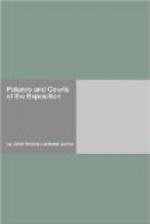The main hall will hold three thousand people.
There are about five hundred conventions to meet here during the time the Exposition is open.
The organ, of marvelous tone and sweetness, is one of the finest in the world.
Edwin H. Lamare of London will give one hundred performances, each recital beginning at 12 M. He starts his musicals the first of June.
The building is French in style, having been inspired by the Beaux Arts Theatre, Paris.
It has a large dome, the cupola of which is lighted by projectors beneath the floor of the building.
Sherry Fry of Iowa has done the sculpture, all of it being suggestive of festivity.
Bacchus, with his grapes and wine skin, reclines on one side, while “The Reclining Woman” listens from her position.
On the west are two Floras with their festoons of flowers.
Little Pan sits with his panpipes on an Ionic capital over which is thrown a fawn skin. He has just stopped playing to watch the lizard that creeps at his side.
The Torch Bearer, a most graceful figure, is poised on each corner dome.
A border of pinkish-lavender hydrangeas, four feet in diameter, with a fringe of lavender and pink baby primroses, adds much to the beauty of this spot.
Pinkish-lavender erica, or heath, borders the steps leading from Festival Hall to the Avenue of Palms.
Above the western entrance one see the old Greek drinking horn, the rhyton, suggestive of festivity.
The Color Scheme
Jules Guerin, probably the greatest man in his particular line in the world, has had complete charge of the Exposition coloring.
He has used only five colors, but of course these colors are not all the same tone.
All walls are pastel pink or a sunset shade, as seen in the Court of the Ages. All niches are the same shade.
All ceilings and shells are ultramarine blue, with two exceptions. The Court of the Ages is a pastel blue, and that of the Court of Palms is fawn-color.
The domes of the Fine Arts Palace, and the Court of the Universe, are burnt orange, or, as one writer has expressed it, “sea-weed washed with brine.”
The other domes are an oriental green, approaching copper-green.
The capitals when colored are burnt orange, with either an ultramarine-blue or an Indian-red ground. Columnettes and a few decorative bands are of turquoise-green.
There is a unity, a balance, a color beauty all unto itself. You see it in the architecture, sculpture, and painting, in the arrangement of the decorations, in the courts. Then over it all hangs the spirit of romance such as surrounds the days of old Castile.
A mediaeval beauty and splendor bring longings for the pageants that would add a world of interest.
There is a Graeco-Roman appeal in the long colonnades, the porticoes, the fountains, the courts.




